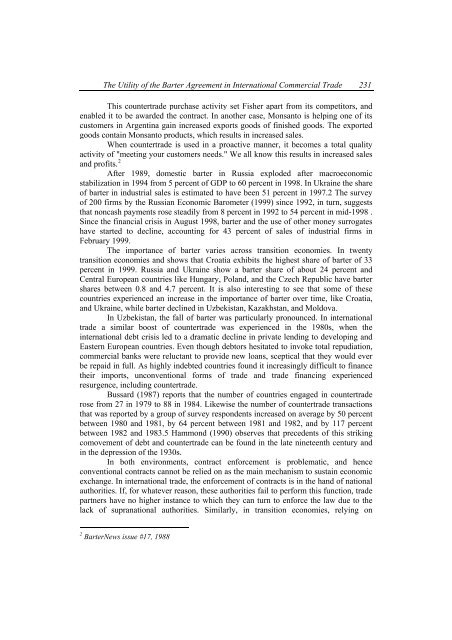annals of the university of petroÅani â¼ economics â¼ vol. xi - part i ...
annals of the university of petroÅani â¼ economics â¼ vol. xi - part i ...
annals of the university of petroÅani â¼ economics â¼ vol. xi - part i ...
Create successful ePaper yourself
Turn your PDF publications into a flip-book with our unique Google optimized e-Paper software.
The Utility <strong>of</strong> <strong>the</strong> Barter Agreement in International Commercial Trade 231<br />
This countertrade purchase activity set Fisher a<strong>part</strong> from its competitors, and<br />
enabled it to be awarded <strong>the</strong> contract. In ano<strong>the</strong>r case, Monsanto is helping one <strong>of</strong> its<br />
customers in Argentina gain increased exports goods <strong>of</strong> finished goods. The exported<br />
goods contain Monsanto products, which results in increased sales.<br />
When countertrade is used in a proactive manner, it becomes a total quality<br />
activity <strong>of</strong> "meeting your customers needs." We all know this results in increased sales<br />
and pr<strong>of</strong>its. 2<br />
After 1989, domestic barter in Russia exploded after macroeconomic<br />
stabilization in 1994 from 5 percent <strong>of</strong> GDP to 60 percent in 1998. In Ukraine <strong>the</strong> share<br />
<strong>of</strong> barter in industrial sales is estimated to have been 51 percent in 1997.2 The survey<br />
<strong>of</strong> 200 firms by <strong>the</strong> Russian Economic Barometer (1999) since 1992, in turn, suggests<br />
that noncash payments rose steadily from 8 percent in 1992 to 54 percent in mid-1998 .<br />
Since <strong>the</strong> financial crisis in August 1998, barter and <strong>the</strong> use <strong>of</strong> o<strong>the</strong>r money surrogates<br />
have started to decline, accounting for 43 percent <strong>of</strong> sales <strong>of</strong> industrial firms in<br />
February 1999.<br />
The importance <strong>of</strong> barter varies across transition economies. In twenty<br />
transition economies and shows that Croatia exhibits <strong>the</strong> highest share <strong>of</strong> barter <strong>of</strong> 33<br />
percent in 1999. Russia and Ukraine show a barter share <strong>of</strong> about 24 percent and<br />
Central European countries like Hungary, Poland, and <strong>the</strong> Czech Republic have barter<br />
shares between 0.8 and 4.7 percent. It is also interesting to see that some <strong>of</strong> <strong>the</strong>se<br />
countries experienced an increase in <strong>the</strong> importance <strong>of</strong> barter over time, like Croatia,<br />
and Ukraine, while barter declined in Uzbekistan, Kazakhstan, and Moldova.<br />
In Uzbekistan, <strong>the</strong> fall <strong>of</strong> barter was <strong>part</strong>icularly pronounced. In international<br />
trade a similar boost <strong>of</strong> countertrade was experienced in <strong>the</strong> 1980s, when <strong>the</strong><br />
international debt crisis led to a dramatic decline in private lending to developing and<br />
Eastern European countries. Even though debtors hesitated to invoke total repudiation,<br />
commercial banks were reluctant to provide new loans, sceptical that <strong>the</strong>y would ever<br />
be repaid in full. As highly indebted countries found it increasingly difficult to finance<br />
<strong>the</strong>ir imports, unconventional forms <strong>of</strong> trade and trade financing experienced<br />
resurgence, including countertrade.<br />
Bussard (1987) reports that <strong>the</strong> number <strong>of</strong> countries engaged in countertrade<br />
rose from 27 in 1979 to 88 in 1984. Likewise <strong>the</strong> number <strong>of</strong> countertrade transactions<br />
that was reported by a group <strong>of</strong> survey respondents increased on average by 50 percent<br />
between 1980 and 1981, by 64 percent between 1981 and 1982, and by 117 percent<br />
between 1982 and 1983.5 Hammond (1990) observes that precedents <strong>of</strong> this striking<br />
comovement <strong>of</strong> debt and countertrade can be found in <strong>the</strong> late nineteenth century and<br />
in <strong>the</strong> depression <strong>of</strong> <strong>the</strong> 1930s.<br />
In both environments, contract enforcement is problematic, and hence<br />
conventional contracts cannot be relied on as <strong>the</strong> main mechanism to sustain economic<br />
exchange. In international trade, <strong>the</strong> enforcement <strong>of</strong> contracts is in <strong>the</strong> hand <strong>of</strong> national<br />
authorities. If, for whatever reason, <strong>the</strong>se authorities fail to perform this function, trade<br />
<strong>part</strong>ners have no higher instance to which <strong>the</strong>y can turn to enforce <strong>the</strong> law due to <strong>the</strong><br />
lack <strong>of</strong> supranational authorities. Similarly, in transition economies, relying on<br />
2 BarterNews issue #17, 1988

















